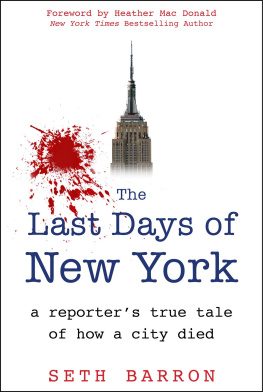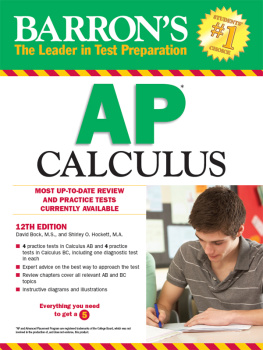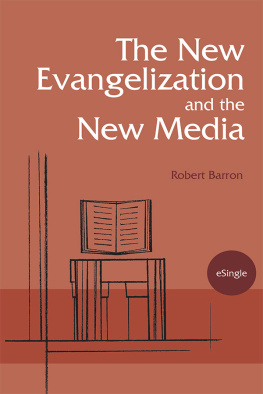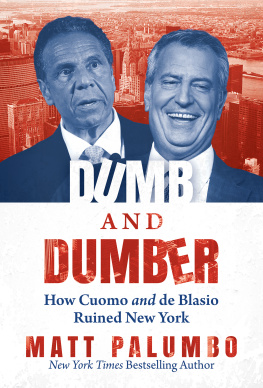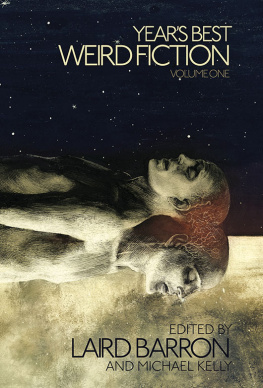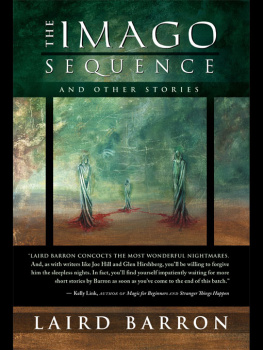Seth Barron - The Last Days of New York: a reporters true tale
Here you can read online Seth Barron - The Last Days of New York: a reporters true tale full text of the book (entire story) in english for free. Download pdf and epub, get meaning, cover and reviews about this ebook. year: 2021, publisher: Humanix Books, genre: Art. Description of the work, (preface) as well as reviews are available. Best literature library LitArk.com created for fans of good reading and offers a wide selection of genres:
Romance novel
Science fiction
Adventure
Detective
Science
History
Home and family
Prose
Art
Politics
Computer
Non-fiction
Religion
Business
Children
Humor
Choose a favorite category and find really read worthwhile books. Enjoy immersion in the world of imagination, feel the emotions of the characters or learn something new for yourself, make an fascinating discovery.
- Book:The Last Days of New York: a reporters true tale
- Author:
- Publisher:Humanix Books
- Genre:
- Year:2021
- Rating:4 / 5
- Favourites:Add to favourites
- Your mark:
The Last Days of New York: a reporters true tale: summary, description and annotation
We offer to read an annotation, description, summary or preface (depends on what the author of the book "The Last Days of New York: a reporters true tale" wrote himself). If you haven't found the necessary information about the book — write in the comments, we will try to find it.
In this gripping new book, Seth Barron warns the city may not recover from the preening, disastrous incompetence of Mayor de Blasio.RAY KELLY, Police Commissioner of New York City
Barron cuts through the noise and provides a devastating account of a citys decline under the delusional leadership of socialists and con men. GREG KELLY, host of Newsmax Greg Kelly Reports
BILL DE BLASIO SET THE STAGE FOR THE RUIN OF NEW YORK CITYTHE LAST DAYS OF NEW YORK: a reporters true tale tells the story of how a corrupted political system hollowed out New York City, leaving it especially vulnerable, all in the name of equity and fairness.
When, in the future, people ask how New York City fell to pieces, they can be toldquoting Hemingwaygradually, then suddenly. New Yorkers awoke from a slumber of ease and prosperity to discover that their glorious city was not only unprepared for crisis, but that the underpinnings of its fortune had been gutted by the reckless mismanagement of Bill de Blasio and the progressive political machine that elevated him to power.
Faced with a global pandemic of world-historical proportions, the mayor dithered, offering contradictory, unscientific, and meaningless advice. The city became the worlds epicenter of infection and death. The protests, riots, and looting that followed the death of George Floyd, and the resurgence of the Black Lives Matter movementcheered on and celebrated by the media and political classaccelerated the crash of confidence that New York City needed in order to rebound quickly from the economic disaster.
Through reckless financial husbandry; by sowing racial discord and resentment; by enshrining a corrosive pay-to-play political culture that turned City Hall into a ticket office; and by using his office as a platform to advance himself as a national political figure, Bill de Blasio set the stage for the ruin of New York City.
As New Yorkers slowly adjust to their new reality, they ask themselves how we had been so unpreparednot so much for the coronavirus, which caught everyone by surprisebut for the economic shock, which was at least foreseeable. THE LAST DAYS OF NEW YORK is the story of how a lifelong political operative with no private-sector experience assumed control of a one-party city where almost nobody bothers to vote, and then proceeded to loot the treasury on behalf of the labor unions, race hustlers, and connected insiders who had promoted him to power.
Bill de Blasios failure to manage the outbreak of Covid-19 is well established. But what is less well understood is how poorly he managed the city up to the point of the pandemic, and how his mismanagement left New York City vulnerable to the social, economic, and cultural shocks that have leveled its confidence and brought into question its capacity to absorb the creative energies of the world, and reflect them back in the form of opportunity and wealth, as it...
Seth Barron: author's other books
Who wrote The Last Days of New York: a reporters true tale? Find out the surname, the name of the author of the book and a list of all author's works by series.

